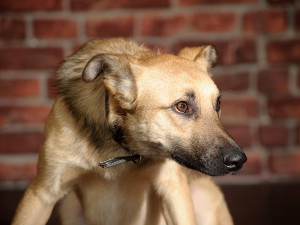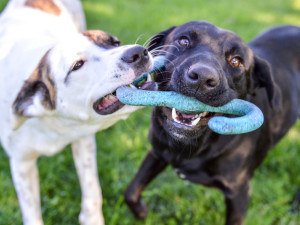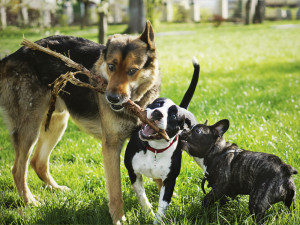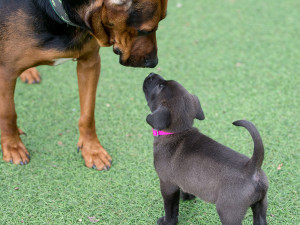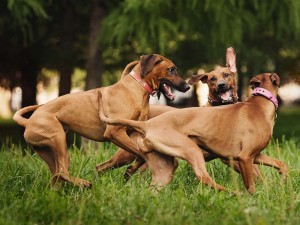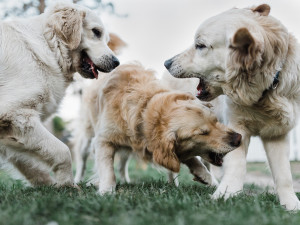Are Your Dogs Arguing With Each Other?
How to tell the difference between dog aggression and communication.

share article

Your pet wants you to read our newsletter. (Then give them a treat.)
Consider this scene from an obedience class for adolescent dogs: Denny, a male Rottweiler, and Meadow, a female Doberman, investigate one another. Denny circles Meadow and tries to mount her from behind for the third time in a row. This proves too much for her. In an instant, Meadow’s lips retract as her body becomes tight, and before we know it, Denny is on the ground with Meadow standing over him, growling. Meadow continues to stand over Denny, whose ears curve back and eyes narrow. When Denny licks and paws at her open mouth, Meadow’s demeanor softens. She steps away and, facing him, folds into a deep play bow. They dance away from their humans like big, romping puppies as we release a collectively held breath.
Most of the pet parents there feared the interaction would end badly. However, Denny and Meadow were not strangers to one another. They had played together regularly in a previous puppy class, but this was the first time they had interacted in a way that raised questions about exactly what they were up to. Were they fighting? Should we have allowed their interaction to play out, or does anything that looks like aggression between dogs immediately call for intervention?
What Does Dog Aggression Look Like?
Because we live with multiple dogsopens in a new tab, study dog behavior and work professionally with aggressive dogs, we think a lot about canine aggression. Some dog interactions clearly qualify as aggressive — for example, a dog with a history of initiating unprovoked attacksopens in a new tab and inflicting damaging bitesopens in a new tab is clearly aggressive, and letting them interact with other dogs is dangerous. No one would disagree about this. However, what about cases where teeth are flashing, spit is flying and the growling is deafening, but in the end, neither dog is injured? This is a gray area that is so very interesting precisely because it’s often not clear-cut. Are these instances of aggression?
The answer depends upon whom you ask. Even among behavioral scientists, the term “aggression” can have so many meanings that, in effect, it has lost its meaning. For example, behaviorists might use the word “aggressive” not only to describe a dog who has killed another dog but also to describe a dog who growls or snarls at a dog who is trying to take their bone. The motivations and emotions are clearly very different in these two examples. In the first case, the dog intended to do harm and did, but in the second case, the dog was likely just communicating their displeasure. Using the same word to describe two completely different scenarios can affect how we think about and respond to a wide variety of dog interactions.
What’s the Difference Between Aggressive and Agonistic Behavior?
Perhaps a more useful term to describe growling at a potential bone thief or the interaction between Denny and Meadow is “agonistic behavior.” Ethologists, who often use this term when studying nonhuman animals, define agonistic behaviors as those that occur between individuals of a particular species in conflict situations.
Examples of agonistic behaviors in dogs include threats like muzzle-puckering and growling; submissive behaviors like crouching, lowering the head and tucking the tail; offensive behaviors like lunging and snapping; defensive behaviors like retracting the commissure (lips) while showing the teeth; and attacking behaviors like biting. With the exception of biting that results in punctures or tears, none of these behaviors necessarily indicates intent to do harm.
Agonistic behaviors simply reveal emotion (e.g., anger or fear), communicate intention (e.g., to maintain control of a resource or to avoid an interaction) or function as a normal part of play fighting (e.g., growling, snapping or inhibited biting). To determine if an interaction meets the criteria for “agonistic behavior,” an observer must focus on an objective description of the communicative patterns displayed rather than automatically jumping to judgments associated with the use of the term “aggression.”
So Why Do Dogs Growl If They’re Not Aggressive?
If signals such as bared teeth and growling are not typically preludes to fighting, why do they exist? Paradoxically, such behaviors are usually about how to avoid fighting. To understand this contention, we need to understand wolves — or, for that matter, our own evolutionary history. Wolves, like our human ancestors, live in family-based groups whose members cooperate to hunt, defend resources and rear young. At the same time, as we know all too well, family members quarrel.
Humans negotiate and move beyond such conflicts with phrases like, “Don’t do that,” “Hey, that’s mine!” “Leave me alone!” or “I’m sorry.” Wolves (and many other social animals) convey similar meanings with a varied repertoire of gestures, postures, facial expressions and sounds, including those mentioned earlier as examples of agonistic behavior. Precisely because they employ such signals, wolves can resolve conflicts without hurting each other. This is an important consideration, because serious wounds in any adult can reduce a pack’s viability as a cooperative unit. Fortunately, dogs, as descendants of wolves, have retained many of these behaviors as well as the motivation — most of the time — to avoid dangerous fights. (One study* reported that none of 127 agonistic interactions observed at a dog park resulted in injury.)
The interaction between Denny and Meadow is a good example of this process. Meadow conveyed the equivalent of “Stop trying to mount me!” when she stood over Denny, growling. Through his submissive expressions and gestures, Denny indicated that he accepted her discipline. Meadow responded to Denny’s submission by stepping away, and her play bow showed that she had no hard feelings. Denny’s willingness to play with Meadow indicated that he, too, wanted to remain friends. While we often rush to intervene in such interactions, you can almost hear the dogs saying, “No big deal!”
Ok But What If Your Dog Is a Major Grouch?
Our last example involves Tex, a 50-pound mixed-breed we rescued from an unhappy life when he was about six months old. He is now five and has never bitten another dog. However, Tex is a bit of a grouch. For example, when he first met Zelda, a young adult female German Shepherd, he rushed at her repeatedly, opening and closing his mouth and vocalizing, “rah-rah-rah.” At first, Zelda showed mild submission and avoidance. Then, as Tex continued with his displays, she stood quietly when he charged, going about her business as soon as he moved away. When they met again the next day, Tex growled at Zelda a few times, but soon they began to play, and from that moment on, they played for hours whenever they were together. Although they clearly like each other, now and then Tex erupts vocallyopens in a new tab at Zelda, who ignores him. She is like the person who has a friend with a bit of a temper, learns not to feed it and loves him anyway.
The point of this story is not that everyone should allow their dogs to interact with grumps like Tex. Zelda’s guardian was a friend who was familiar with Tex and knew that he was harmless, despite his tendency to show agonistic behavior toward an unfamiliar dog. Although we might prefer that dogs always greet one another with laidback ears and loosely wagging tails, we wonder how many dogs like Tex are out there, doomed to a life without canine company simply because they don’t conform to our ideas about how dogs should behave? If we can learn to discern nuances in agonistic behavior, perhaps more dogs will get a chance to enjoy friendships with other pups.
So, the next time you witness an agonistic interaction between two dogs known to have good bite inhibitionopens in a new tab, instead of intervening at the first sign of a curled lip or growl (especially when the dogs have a generally amicable relationship), wait a moment and watch. If the interaction ends quickly with no injuries to either party, chances are you have witnessed a useful episode of communication. Sometimes, we need to trust that the dogs really do know best.
To avoid misunderstandings, we need to issue a few caveats.
Many incidents of seemingly aggressiveopens in a new tab behavior between dogs are simply examples of appropriate communication. Dogs (including puppies) often recognize this even when we don’t but here are some limitations to this idea:
1. When we say that most conflicts are resolved without fighting, we are referring to puppies or adult dogs who have interacted frequently with other dogs and don’t have a history of injurious biting. Such socialization is critical, not only to help dogs learn how to use agonistic signals appropriately, but also to counteract a tendency in some dogs to view unfamiliar dogs as potential enemies.
2. When we suggest that it is sometimes appropriate to allow agonistic behaviors to proceed without intervention, we are referring to pairs of well-socialized dogs who already know each other. Before first introducing two dogs — even well-socialized ones — the pet parents should exchange information about each dog’s history and personality and then proceed with caution until the dogs repeatedly interact in friendly ways.
3. Pet parents may need to intervene sooner rather than later when one dog within a pair is especially vulnerable — for example, in conflicts between large and small dogs or those involving old dogs. Additionally, if arousal increases rapidly in one or both dogs with no signs of abatement, it is wise to avoid further escalation by interrupting and redirecting the dogs.
4. We are referring only to pair-wise agonistic interactions. Once a third dog becomes involved, intervention may be needed to prevent two or more dogs from ganging up against another. Finally, we’re mostly discussing interactions outside of play.
Barbara Smuts, PhD
Barbara Smuts, PhD holds an undergraduate degree in anthropology and a doctorate in behavioral biology from Stanford Medical School. A professor of psychology, she teaches courses in animal behavior at the University of Michigan. She has studied social behavior in several wild animals, including olive baboons and chimpanzees (East Africa) and bottlenose dolphins (coastal Western Australia). More recently, she has been studying social relationships among domestic dogs and is working on a book on this subject.
Camille Ward, PhD
Camille Ward, PhD received her doctorate from the University of Michigan, studying cognition and the development of social behavior in dogs. She has lectured widely on dog behavior at scientific and dog-training conferences, and she is the owner of About Dogs LLC, a specialty practice in Ann Arbor, Mich.
Related articles
![Three dogs biting a stick.]() opens in a new tab
opens in a new tabSome Like It Rough: Playing Vs. Fighting
Two animal behavior experts agree it’s usually play fighting. Here’s how you can tell.
![Big dog meets little brown puppy for the first time]() opens in a new tab
opens in a new tabGetting a Second Dog?
Use these tips before making the big decision.
![Rhodesian Ridgeback dogs playing in summer grassy field]()
Understanding Canine Social Hierarchies
In case you’ve ever wondered what it’s like to live in a dog society.
![Three golden retriever's playing in the grass.]() opens in a new tab
opens in a new tabHow Do I Break up a Dog Fight?
Keep you and your dog safe in case of a dog fight emergency.
